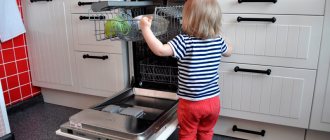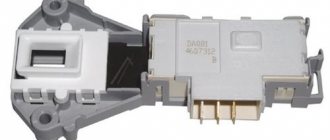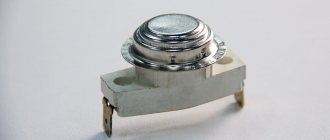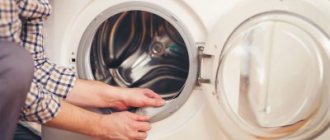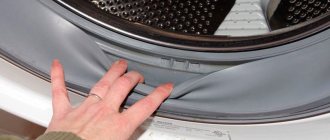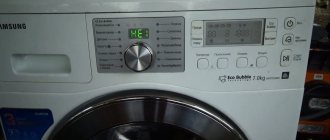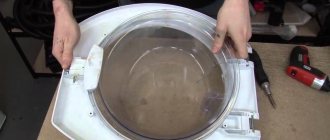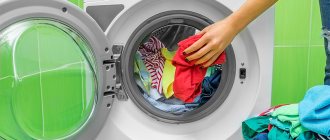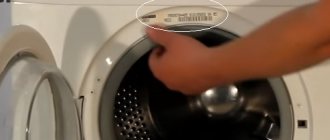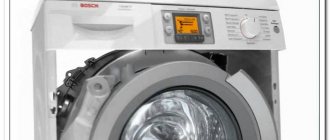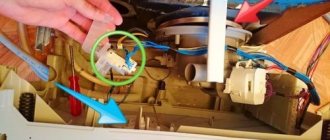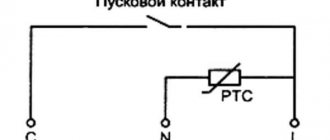The washing machine lock is a safety mechanism that ensures it remains sealed during operation. The lock prevents the lid from opening inadvertently during operation, and also stops the washing program if the hatch is not closed tightly. Like the main part of the parts, the lock is subject to wear, so it is necessary to replace it in a timely manner.
Lock device
Note that there are a large number of variations of locks. Manufacturers of washing machines install different locks on their models, which differ in shape, size, and method of fastening. They also differ in their operating principles. There are mainly two types used:
- thermal;
- electronic.
One of the UBL options
Thermal UBL
At the heart of the thermal lock is an RTS resistor and (or) a bimetallic plate. After closing the hatch and starting the washing program, a voltage of 220 volts is supplied to the resistor. It begins to heat up quickly and simultaneously heats the plate, which bends.
As a result, it blocks the hatch hook using a latch, preventing it from opening during the wash cycle. The bimetallic plate also closes the control contact, as a result of which the selected program begins to be executed.
The diagram and principle of operation of such a lock is shown in the figure below.
Note that markings in the form of letters: N, L and C are often present on the UBL contacts, which makes it easier to check. Instead of an RTS thermistor, a winding made of high-resistance wire can be used. And also two resistors are used in some models, which does not change the principle of operation.
Let us repeat that locks vary in shape, size and fastening, and if you need to purchase them, you need to select them according to the product number of the machine.
Simple thermal lock
This type of lock opens itself after the wash is completed. This is both a plus and a minus. The main disadvantage is that the opening takes place after 2-3 minutes, since the bimetallic plate needs time to cool and take its original shape, thereby releasing the tongue that holds the door. Most washing machines have a light indicator for holding the hatch.
Expert opinion
I work in the household appliance repair industry. Extensive experience in restoring washing machines and dishwashers.
Ask a Question
Important! Neglecting the cooling time leads to breakage of the lock mate, which is located directly in the door.
Such UBLs are used in inexpensive models “Indesit”, “Ariston”, “Beko”, “LGi”, “Samsung”, “Ardo”, “Whirlpool”.
Electronic lock
An electromagnet is added to such a locking device, which is controlled by pulses coming from the module. And also in such UBLs there may also be an RTS resistor. In this case, the thermistor with a bimetallic plate closes the control wire, and the electromagnet moves the latch that blocks the hatch.
The castle is shown schematically in the figure below.
Sometimes such a UBL is called instantaneous, because locking and unlocking occur instantly. This is an undeniable advantage.
Such devices are installed on models of the mid-price level and above, such as: Electrolux, Zanussi, Kandy, Bosch, Siemens, AEG. There is only one drawback: the verification is difficult.
A hatch with such a UBL can be opened only if the following conditions are met:
- the machine is connected to the electrical network;
- none of the programs are running;
- there is no water in the drum;
- The engine does not rotate.
Note that washing machines with such locks are equipped with emergency opening devices, which are usually located in the area of the drain pump filter cover.
Burnt electronic lock
What does the closing module consist of?
Before disassembling the hatch locking device, it is worth understanding what it is, what parts the mechanism consists of, and how it works. Modern automatic machines are equipped with bimetallic locking locks. This module is very reliable - it will not allow the door to be opened during washing. So, the washing machine door lock includes:
- thermocouple;
- fixing “tongue”;
- bimetallic plate.
The operating principle of the door locking module is as follows:
- the control unit supplies current to the lock thermocouple;
- The thermoelement heats up in 1-3 seconds;
- the charge is transferred to the bimetallic strip;
- the plate changes in size and puts pressure on the latch;
- The “tongue” falls out and remains in a special recess.
A characteristic click will notify you that the door lock has been activated.
The hatch opens in the same way, only all steps are performed in reverse order. When the current supply is stopped, the bimetallic plate changes shape, the latch “comes out” of the groove and “falls” into place. The door lock is removed.
It should be understood that on most models of washing machines, the UBL operates only 1-3 minutes after the completion of the cycle. Therefore, you should not forcefully try to open the door right away. You need to wait until the plate cools down and the control module makes sure that there is definitely no water left in the tank.
If the hatch does not open even after 10-20 minutes, most likely the mechanism has malfunctioned. For what reason the blocker may break, how to check and repair it, we will tell you further. The locking device is located on the front wall of the housing, to the right of the drum door. Its location is revealed by a small rectangle that protrudes slightly outward. This is exactly the groove where the “tongue” of the lock fits.
Examination
At home, you can only fully check the thermal UBL. To do this, you will need a multimeter, a screwdriver (slotted or Torx) and an electrical extension cord.
First, pull the device out of the case. To do this, remove the collar from the cuff and pull back the edge next to the lock. Then unscrew the two screws that secure the lock to the body and pull it out. We pull off the chip. UBL is ready for diagnostics.
Expert opinion
I work in the household appliance repair industry. Extensive experience in restoring washing machines and dishwashers.
Ask a Question
Don't forget to turn off the power to the washing machine before doing this work!
Standard marking of thermal lock: N,L,C. A resistor passes through N and L. There is a certain resistance at these contacts. The remaining couples are broken up. If the contacts are numbered differently, you can tell by the resistance.
Another option is to connect the light bulb alternately to the terminal contacts, turn on the CMA and run the program. On the contacts that go to the resistor, the light will light up brightly.
Mechanical problems
Mechanical problems may include worn locks or other external damage. This occurs due to excessive load on the door. Small children can ride on it or wet clothes are often hung on it after washing. Breakage can also occur if the hatch is slammed too hard.
Skewed loops and tongue
If there is no clothes in the washing machine, but something is still preventing the door from locking, then you need to check the locking tab and hinges. They are the main functional parts of the washing machine hatch.
To eliminate this malfunction, you need to adjust the door level. You also need to check the tightness of the fasteners. If the adjustment does not help, the parts that have become unusable should be replaced.
To replace the hinges you need:
- Remove the door from the washing machine body.
- Unscrew the screws that connect the two parts of the door.
- Separate the parts using a little force. It is better to try pressing in different parts of the door, otherwise you may break the body.
- Remove the loop and replace it with a new one.
- Assemble the door body.
- Set it in place.
Boris Vitalievich
head master
Call a specialist
If the problem does not disappear after replacing the hinges, then the locking tab needs to be replaced. To do this, the door is disassembled and a new one is installed in place of the damaged tongue.
Handle breakage
Sometimes the washing machine door does not open. The laundry had already been washed, but the handle on the lid broke and the door was locked. In this case, you can use the emergency hatch opening function (press the power button three times). But how to completely get rid of this problem?
To change the door handle to a new one, you must:
- Remove the door from its hinges.
- Unscrew the screws and separate the plastic halves of the cover.
- Remove the glass.
- Pull out the rod to which the handle is attached. To do this, push a long thin wire or nail into the bolt and pry up the rod.
- Pull out the handle.
- Install a new handle.
- Reassemble the door by performing the steps in reverse order.
Guide deformation
If the guide breaks, it will not be possible to close the hatch at all and the machine will not start the wash. Most often, guides are made of plastic, and this material quickly wears out during operation.
You can fix the problem yourself. But you need to understand that the guide cannot be repaired. It is necessary to purchase a new part and install it to replace the one that has become unusable.
To change the plastic guide, you need:
- Get rid of the old cuff.
- Separate the housing parts.
- Unscrew the screw.
- Pull the latches towards you.
- Disconnect the plastic clamps.
- Clean all parts from dirt and dust.
- Install a new part.
Garbage in UBL
If debris gets into the hatch locking device, the machine door stops locking. Since the heating resistor also works simultaneously with the blocking device, the resistance increases with increasing temperature. Therefore, over time, the plates shift and become deformed. The washing machine door is secured by a lever connecting the guide to the latches. When the washing process stops, the temperature of the resistor becomes lower and the contacts return to their original position. If a foreign object gets into the UBL, then disruptions begin in this harmonious process.
To clear the blocking device from debris, you need to disassemble the washing machine. Then the device must be pulled out and checked for foreign objects. If necessary, clean the blocker and reinstall it. We will tell you more about how to remove the UBL from the washing machine below.
Replacing UBL
If the lock is faulty, it all comes down to replacement. Restoring functionality does not make sense, because all damage occurs due to overheating.
You can carry out repairs yourself without involving a technician from a service center. To do this you will need: a slotted and Phillips screwdriver, as well as a little skill.
Let's take a closer look at all the actions:
- We remove the clamp. As a rule, it is a circle made of wire and a steel spring. We find it with our hands and pry it off with a slotted screwdriver. We tighten the clamp.
- We pull off part of the cuff in the area where the lock is attached.
- Unscrew the two screws that secure the lock.
- We remove the UBL by hand into the space between the cuff and the body.
- We pull the chip.
- We install a new lock.
- We put it inside the car and fasten the screws.
- We put the cuff back on, carefully working with our fingers.
- Reinstall the clamp. Here you will need the help of another person, or a second screwdriver.
Be sure to check that the hatch is closed. It should click into place.
Cuff with ul
Replacement can only be done if the door opens. Because the mounting screws are covered by the hatch. And if it is closed, then the replacement will not be possible. We will consider what to do if the hatch is blocked in another material.
What causes breakdowns?
The washing machine door closing sensor usually breaks down for two reasons. Most often, the malfunction of the lock is caused by simple wear and tear of the mechanism parts due to long-term operation of the machine. So, over and over again, when heated, the plate deteriorates, and after a few years the fixation weakens to a minimum. If this is the case, repairing the lock will be impractical; it is better to remove the old one and install a new UBL.
In addition, problems with the electronics of the machine may cause a malfunction of the locking device. The issue may be that:
- voltage drops in the electrical network “break through” the thermal element of the lock, it stops heating and transferring charge to the plate and hook;
- The triac on the board, which is responsible for the operation of the blocker, closes, as a result of which current is constantly supplied to the UBL, so the door lock is not removed.
Mechanical reasons also lead to disruption of the UBL operation. The door may not come off if there is sagging or the hinges on which it is attached are deformed. In addition, the “tongue” itself in the lock may break. To prevent such problems, it is important not to hang things on the hatch and not allow children to ride on it.
Understanding the principle of operation and the design of the locking lock, you can independently determine the cause of the breakdown. We'll tell you how to diagnose the mechanism yourself. Having found the problem, all that remains is to fix it and continue washing.
A little about security
The operating principle of the UBL washing machine is based on user safety. Without locking the door, no program starts, water does not pour, and the drum does not rotate.
Expert opinion
I work in the household appliance repair industry. Extensive experience in restoring washing machines and dishwashers.
Ask a Question
Theoretically, it is possible to bypass the blockage, at least the thermal one. But this is absolutely forbidden. If some “handyman” does this, he will endanger everyone who uses the machine!
Important points:
- The SMA must be grounded.
- The panel must have an RCD. It will allow you to detect possible current leaks.
- Do not lift the machine to a height, especially on a shelf. Over time, the shock absorbers wear out, and when spinning, the washer may move or even bounce.
- If you have small children, then purchase an SMA with a child lock feature and activate it.
- If water appears, call a professional.
- If the inlet hose is not equipped with the Aquastop system, then after the end of the washing cycle, turn off the water supply valve.
These simple tips will save your nerves and keep you and your loved ones safe.
Washing machine door closing sensor
Any automatic washing machine is equipped with a door closing sensor. The element is associated with a lock, and together this mechanism is called a hatch locking device. Only after the UBL is activated, the machine can start washing.
The washing machine door closing sensor sends a signal to the control module that the system is sealed, and the “brain” starts the cycle. If such information is not received on the board, the wash does not start. Let's figure out what the UBL consists of and how, if necessary, to check and repair the mechanism.
Repair of damaged glass
Damaged glass is more difficult to repair. Here you will need to use polyester or epoxy resin. After removing the door, you should consider removing the glass. Most often it is not removed. Therefore, they repair it like this:
- A plastic film is glued to the front surface. You may need to use tape. Gaps are not allowed.
- Reinforcing tape is placed on the existing hole that requires sealing (it is used for plastering work).
- Prepare the resin in a separate container according to the instructions. Mix the base and hardener in the required proportions.
- After preparing the resin, it is poured into the desired location.
- Typically polymerization occurs within 24 hours. After this time, the plastic film is removed.
- Smudges are removed using sandpaper.
This is how easy it is to repair the glass on a washing machine door.
Mechanical problems
Mechanical problems may include worn locks or other external damage. This occurs due to excessive load on the door. Small children can ride on it or wet clothes are often hung on it after washing. Breakage can also occur if the hatch is slammed too hard.
Skewed loops and tongue
If there is no clothes in the washing machine, but something is still preventing the door from locking, then you need to check the locking tab and hinges. They are the main functional parts of the washing machine hatch.
To eliminate this malfunction, you need to adjust the door level. You also need to check the tightness of the fasteners. If the adjustment does not help, the parts that have become unusable should be replaced.
To replace the hinges you need:
- Remove the door from the washing machine body.
- Unscrew the screws that connect the two parts of the door.
- Separate the parts using a little force. It is better to try pressing in different parts of the door, otherwise you may break the body.
- Remove the loop and replace it with a new one.
- Assemble the door body.
- Set it in place.
Boris Vitalievich
head master
Call a specialist
If the problem does not disappear after replacing the hinges, then the locking tab needs to be replaced. To do this, the door is disassembled and a new one is installed in place of the damaged tongue.
Handle breakage
Sometimes the washing machine door does not open. The laundry had already been washed, but the handle on the lid broke and the door was locked. In this case, you can use the emergency hatch opening function (press the power button three times). But how to completely get rid of this problem?
To change the door handle to a new one, you must:
- Remove the door from its hinges.
- Unscrew the screws and separate the plastic halves of the cover.
- Remove the glass.
- Pull out the rod to which the handle is attached. To do this, push a long thin wire or nail into the bolt and pry up the rod.
- Pull out the handle.
- Install a new handle.
- Reassemble the door by performing the steps in reverse order.
Guide deformation
If the guide breaks, it will not be possible to close the hatch at all and the machine will not start the wash. Most often, guides are made of plastic, and this material quickly wears out during operation.
You can fix the problem yourself. But you need to understand that the guide cannot be repaired. It is necessary to purchase a new part and install it to replace the one that has become unusable.
To change the plastic guide, you need:
- Get rid of the old cuff.
- Separate the housing parts.
- Unscrew the screw.
- Pull the latches towards you.
- Disconnect the plastic clamps.
- Clean all parts from dirt and dust.
- Install a new part.
Garbage in UBL
If debris gets into the hatch locking device, the machine door stops locking. Since the heating resistor also works simultaneously with the blocking device, the resistance increases with increasing temperature. Therefore, over time, the plates shift and become deformed. The washing machine door is secured by a lever connecting the guide to the latches. When the washing process stops, the temperature of the resistor becomes lower and the contacts return to their original position. If a foreign object gets into the UBL, then disruptions begin in this harmonious process.
To clear the blocking device from debris, you need to disassemble the washing machine. Then the device must be pulled out and checked for foreign objects. If necessary, clean the blocker and reinstall it. We will tell you more about how to remove the UBL from the washing machine below.
